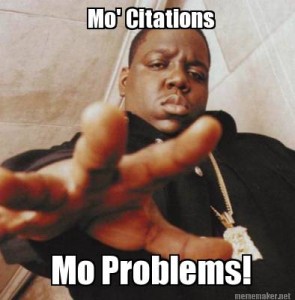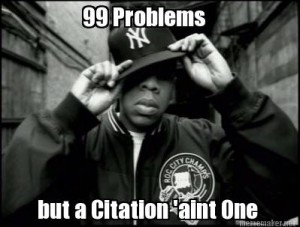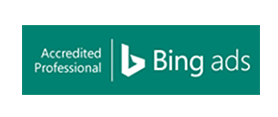It is fairly well documented how important citations are as part of your local SEO efforts and how the quality and the total number of citations can play a big part in raising the visibility of your business in localised search results. With this in mind, most of the local SEO articles out there tend to list a series of directories and tell the business owner to dive in and get their business listed.
Now, that is fine in many cases, but it fails to address one important point: what citations already exist for your business?
How Search Engines Use Citations
Citations are essentially mentions of your business on other websites and the search engines use these mentions to help establish a trust that you are who you say you are and you are where you say you are. Now, everything else being equal (which it never is), the business with more citations will be more visible in local (and even localised organic) search results.
Trust
Trust is an important factor in natural SEO and trust is even more important in local SEO. How much does the search engine trust that you do what you say you do? How much does the search engine trust that you are where you say you are? Citations, especially from more trusted providers (Yell, Thomson etc) certainly help as these providers utilise postcards, phone calls and emails to verify address details. The more citations you have as well then, the more confirmations they have to use that you are where you say you are and that people are talking about you. So, as part of an overall system that is going to look at your Google+ local page, reviews and existing site (if one exists) it is clear that citations are a useful way for the search engines to trust the information you tell them (or they gather). They can then use this trust to help them determine if and where you deserve to be placed in any localised search engine results.
Noise
If we are looking to improve our rank in the local search results we want to do all the standard local SEO jobs that need doing including building citations but we must also consider anything that may interfere with this signal we are trying to send to Google.
We want a clean and clear transmission of our name, address, phone number (NAP) + website address and the services we offer – but often, there may be noise and interference that affects the clarity of the signal we are trying to send out. So, to ensure we send a clear signal we must consider:
- Have you ever changed your business name? Even a little bit?
- Do any other companies or organisations have a similar name?
- Have you ever changed business address?
- Have you ever changed the phone number?
- Has your website address ever changed?
For most businesses, one or more of these will be true and for many businesses, you are going to find that most if not all of these are true. To make matters worse many businesses will have moved more than once and may have had multiple phone numbers over time – all of this contributes to the noise and interference in our NAP signal (without even considering all the ones that are just incorrect). Now, adding more correct citations can help with this but certainly not as much as if we put these existing ones right as well.
Bowler Hat – A Recent History
To give you an idea of how this can quickly get out of hand, even for a small and newish (several years) business lets have a look at the history of Bowler Hat.
- Name * 3 – our name was originally Bowler Hat Solutions, the business name is Bowler Hat Internet Services Ltd and we have recently taken to just calling things Bowler Hat. We also have to consider that Bowler Hat is a somewhat odd name and most folks searching for ‘Bowler Hat’ are not looking for us (yet).
- Address * 4 – the business was registered at my home address at the time, then I moved to an office in The Jewellery Quarter, then a bigger office in the Jewellery Quarter, then to our current home at the Custard Factory in Birmingham. I also have the registered office at another address so we have four and possibly five locations associated with the business.
- Phone Number * 2 – Phone is one element that has been fairly static for us but really, that is luck more than anything else as we went with a VOIP system many moons ago and rent our local number which forwards to the VOIP number. Still, we have had two numbers in the entire history of the business.
- Website – we used to use the www.BowlerHatSolutions.co.uk domain but when I realised that the ‘solutions’ part meant absolutely nothing and was a daft cliche (my bad) I sought out and finally obtained www.BowlerHat.co.uk which is our current home.
So, even for a small and relatively new business like ours, we have had four addresses, three name variations, two phone numbers and two website addresses. These have all been at different times so using the same system used to determine the lottery odds we can determine that there are a whole bunch of possible NAP variations out there for us.
(4 addresses) * (3 names) * (2 phone numbers) * (2 web addresses) = 48 possible NAP variations (eek!)
Mo Locations, Mo Problems
 Now consider bigger businesses, more moves, more history, multiple active offices (that may themselves have moved), multiple phone numbers, shared phone numbers, mergers, rebranding – before long the relative simplicity of Local SEO can take on a whole new level of complexity. Just add ten locations to my example above and we have nearly 500 variations and a whole lot of chin stroking when your locations are not ranking in localised search despite having knocked out the 50 obvious citations for your office.
Now consider bigger businesses, more moves, more history, multiple active offices (that may themselves have moved), multiple phone numbers, shared phone numbers, mergers, rebranding – before long the relative simplicity of Local SEO can take on a whole new level of complexity. Just add ten locations to my example above and we have nearly 500 variations and a whole lot of chin stroking when your locations are not ranking in localised search despite having knocked out the 50 obvious citations for your office.
Signal Interference
Search engines are not people and no matter how clever and complicated they get they are looking to use signals to determine levels of trust in the information (results) they return to their users. So, if we can change our mindset a little and realise we are building citations to send a clear message to Google then we must also consider anything that could negatively affect that pristine, clear signal and to do that we must audit all historical mentions of the business and it’s various names, addresses, phone numbers and websites.
A Simple Citation Audit
So, assuming we have some out of date citations out there we want to know:
A) how to find them
B) how to change them
C) how to make sure they have been updated.
Now, I wish the solution was easy but it requires some good old fashioned research, organisation and hard work to get the job done.
Tools of the Trade
We are going to need a couple of tools to do our job properly:
- A spreadsheet and some spreadsheet software
- Email – I would recommend Gmail as it gives us some simple automation to resend emails to our targets
- Google & some Google-Fu
Now, if you are doing some local SEO you may have come across the various citation tools out there and these can be useful but I would really recommend that you do things the old fashioned way here. Sure, you can use citation trackers if you want and go after your old addresses but this approach will give us some flexibility.
Spreadsheet
For your spreadsheet, I would recommend Google docs but you can use Excel or the Open Office Calc spreadsheet which are totally free (so no excuses).
We don’t need anything over complicated here in our spreadsheet but we will want to keep track of the following details:
- URL
- contact email
- contact page
- date contacted
- times contacted
- status of the incorrect citation
- position *
* position is used if you want some way to prioritise the good, bad and the ugly of the citations so we have a simple way to order them by relative importance (far from perfect but it suits our needs here) – that is, don’t sweat the little things and if a crappy site has no contact form then it is probably not a big deal.
We are going to have to email folks to request the removal or ideally updating of the incorrect citations we find so you can really use any email client or system you like. Personally, I would plumb for Gmail and primarily because of the Boomerang plugin. Boomerang allows us to configure reminders for when we don’t get a response so we can simplify the badgering that is often needed to facilitate a response.
You may also find that you have better results sending emails from your own domain <[email protected]> so the winning solution is running your email through Google apps so you can use the wealth of Gmail plugins + your own URL for credibility when making requests.
Google-Fu
We are primarily concerned with Google here so using Google to find citations gives us the benefit of seeing them returned in an order that likely indicates the importance of each listing. So, seeing as we will likely have several sets of results, if we note down the position they appeared within the results in our spreadsheet then it gives us a loose guide of importance (it’s not perfect by any means but higher up means more important and in this case a column of that data gives us a simple sorting option + this ignores anything not indexed).
Finding your Citations
We have four important elements to consider here:
- Name
- Address
- Phone Number
- URL
So, before we can really proceed we need to list all possible variations for each of our four elements. If we again use Bowler Hat as an example we have the following. (Note: I am not going to detail our previous addresses on this page, that would be a citation of sorts, and given that this is an article detailing how to clean up old citations, well, that would be stupid).
Name
BowlerHat
Bowler Hat (correct)
Bowler Hat Solutions
Bowler Hat Internet Services Ltd
Address
112 Zellig – The Custard Factory, Gibb Street, Digbeth, Birmingham, B9 4AA
xxxb The Big Peg, xxxx Street, xxxxxxxxxxxxx, xxxxxxxx, Birmingham. Bxx xxx
xx xxxxxx Road, xxxxxx xxxxxxxxx, xxxxxxxxx, Bxx xxx
xx xxxxxxx Road, xxxxxxxxx, xxxxxxxx, Wxx xxx
Phone Number
0121 314 2001 (current)
0121 xxx xxxx
URL
www.bowlerhat.co.uk (current)
www.bowlerhatsolutions.co.uk
*.bowlerhat.co.uk
*.bowlerhatsolutions.co.uk
Finding Your Old Citations
So now it’s time to actually start searching for those old citations so I suggest the following queries:
- site:www.yourcurrenturl.co.uk “name”
- site:www.yourcurrenturl.co.uk “postcode”
- site:www.yourcurrenturl.co.uk “old phone number”
- site:www.yourcurrenturl.co.uk “oldurl.co.uk”
Now, you can play with this a bit and mix up name, postcode, phone number etc but you must be pragmatic and cover off all variations so I almost prefer a simplified approach. Also, remember to go with all variations so to look at my own business name and only leave listings with “Bowler Hat” I must do the following:
- site:www.bowlerhat.co.uk “bowlerhat”
- site:www.bowlerhat.co.uk “bowler hat solutions”
- site:www.bowlerhat.co.uk “bowler hat internet services”
- site:www.bowlerhat.co.uk “bowlerhat internet services ltd”
Just for clarity here, when we use -site: we are removing all listings from that site so we are making sure to pull your own site out of any of those results. Just for kicks, you can do the same search without the minus to ensure you have no references to the old addresses on your own site as that won’t help and is an easy fix.
Removing any Duplicates
Your spreadsheet may well end up with some duplicates via this approach so it makes sense to get it all in there and do some data cleansing. If you order by URL & position and then remove any duplicates we are pretty much good to go. There are actually some more whizz-bang solutions to clearing out duplicates but that is spreadsheet dependant so I’ll let you practice your Google-Fu on that if you’re working with a large dataset and the above is not practical.
Contacting Site Owners
Now the worst bit – we must contact all site owners and ask them to take down the incorrect listings. Now, an important point here is that duplicates are bad so as much as we don’t want a correct and incorrect listing on a single site we don’t want two correct listings on a single site.
So, starting at the top of our spreadsheet we must do the following for each listing:
Step 1 – identify if any other citations exist on this site
- Pick the first (or next) URL on your list
- Search the site by any means available (search box etc & remember the various names etc)
- Use Google: site:www.citationsource.com “business name”
- If you find just the bad one then ask for it to be updated
- If you find a good and a bad citation then point out the duplication and out of date listing
You can contact the site owner via any available means on the site so that may be either a contact form or email address. Be sure to add this to your spreadsheet along with the date you contacted them. Also, if there are multiple addresses, don’t be shy, copy in a few folks and get that message out there.
An example Email
Address 1
Address 2
Address 3
Post Code
X
Note: If a correct listing already exists then simply point them to the incorrect and correct and ask them to remove the bad and keep the good.
Rinse & Repeat
Now it’s just a case of working down your list. Search the site for further listings and contact the site owner to either remove or update the listing.
Follow Up
Now many people won’t get back to you. Many will. Some will update straight away, others will take a little more badgering. You must double check whenever someone claims to have removed the listing and update your trusty spreadsheet. We tend to schedule in time to do this every week and have at least four attempts at getting something removed. Once we have hit a wall with this we have been known to make phone calls and find alternative emails. A dogged, persistent approach will help you get more cleaned up!
When you do finally get to the list of ones that you can’t budge well, review them. Check the quality of the site, check the page and domain authority with Open Site Explorer and even your own position value from your spreadsheet. High-quality sites will want to update the listing data and any other sites that don’t get back to you are likely citation graveyards and will carry little if any trust (and will likely soon be deindexed if the owners have abandoned ship).
Consistent Citations = low noise, high trust & better rankings!
Citations are still a huge part of the local ranking algorithm but getting them right is a whole lot more difficult than just paying someone on fiverr.com to go out and get you a whole bunch of new ones. It takes time and effort and cleaning up what is already out there is often more important than grabbing a bunch of new ones.

99 Problems but a Citation ‘Aint One
If you clean up your old and incorrect citations to ensure your NAP is squeaky clean across all data sources and ensure you have all the important citations and have focused relentlessly on the quality of the citations you have built then you can likely rest happy that your citations are pretty much dialled in. You will want to update, add new pictures, offers, keep adding reviews and just keep them fresh but you should be able to get to a point where you have the job done and it just requires light maintenance going forward. You can then sit back and you will see improved local results – it may take 3 to 6 months but it will happen.
What next? Well, local SEO is a complicated beast once you get past the basics so if you think you have everything dialled in then you may want to read the Local SEO ranking Factors published over at Moz.com as it may give you a few new angles to look at.
Hope that helps folks and is not just another tired old list of the best citation sources. Please share the article around the social web and give me a shout with any questions in the comments below. (I am on holiday for a week as I put this out so give me a bit of time to reply).






